会话含义
- 格式:doc
- 大小:40.00 KB
- 文档页数:5
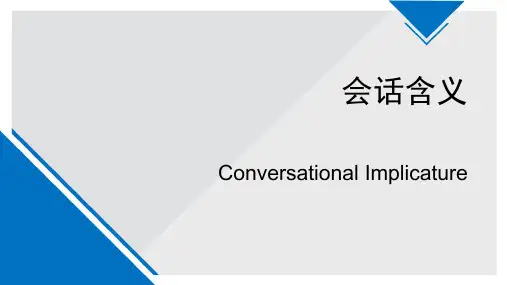
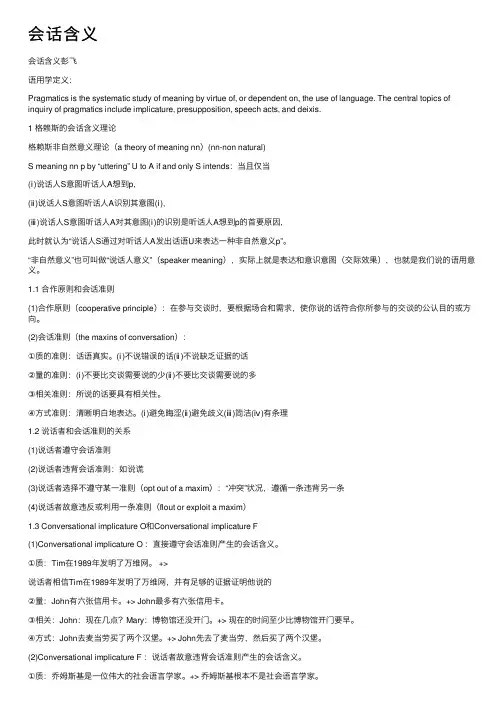
会话含义会话含义彭飞语⽤学定义:Pragmatics is the systematic study of meaning by virtue of, or dependent on, the use of language. The central topics of inquiry of pragmatics include implicature, presupposition, speech acts, and deixis.1 格赖斯的会话含义理论格赖斯⾮⾃然意义理论(a theory of meaning nn)(nn-non natural)S meaning nn p by “uttering” U to A if and only S intends:当且仅当(ⅰ)说话⼈S意图听话⼈A想到p,(ⅱ)说话⼈S意图听话⼈A识别其意图(ⅰ),(ⅲ)说话⼈S意图听话⼈A对其意图(ⅰ)的识别是听话⼈A想到p的⾸要原因,此时就认为“说话⼈S通过对听话⼈A发出话语U来表达⼀种⾮⾃然意义p”。
“⾮⾃然意义”也可叫做“说话⼈意义”(speaker meaning),实际上就是表达和意识意图(交际效果),也就是我们说的语⽤意义。
1.1 合作原则和会话准则(1)合作原则(cooperative principle):在参与交谈时,要根据场合和需求,使你说的话符合你所参与的交谈的公认⽬的或⽅向。
(2)会话准则(the maxins of conversation):①质的准则:话语真实。
(ⅰ)不说错误的话(ⅱ)不说缺乏证据的话②量的准则:(ⅰ)不要⽐交谈需要说的少(ⅱ)不要⽐交谈需要说的多③相关准则:所说的话要具有相关性。
④⽅式准则:清晰明⽩地表达。
(ⅰ)避免晦涩(ⅱ)避免歧义(ⅲ)简洁(ⅳ)有条理1.2 说话者和会话准则的关系(1)说话者遵守会话准则(2)说话者违背会话准则:如说谎(3)说话者选择不遵守某⼀准则(opt out of a maxim):“冲突”状况,遵循⼀条违背另⼀条(4)说话者故意违反或利⽤⼀条准则(flout or exploit a maxim)1.3 Conversational implicature O和Conversational implicature F(1)Conversational implicature O :直接遵守会话准则产⽣的会话含义。

会话含义-读书笔记在第四章《会话含义》中,主要讲的是美国语言哲学家格赖斯提出的合作原则以及会话含义理论。
首先,格莱斯认为,在人的交往过程中,彼此的交谈并非杂乱无章的,是有条理的连贯的对话,对话参与者在某种程度上都意识到一个或一组共同的目的,或者至少有彼此都接受的方向,因此,在对话过程中,参与者会“默契”的朝着一个对话方向进行,使交谈得以顺利进行。
而这种维护对话的进行地“默契”,像是参与者共同遵守的一般原则:合作原则,即在参与交谈时,要使你说的话符合你所参与的交谈的公认目的或方向。
合作原则具体表现有四点准则:1.数量准则:指所提供的信息量。
所说的话应包含为当前交谈目的所需要的信息;所说的话不应包含多于需要的信息。
2.质量准则:所说的话力求真实。
不要说自知是虚假的话;不要说缺乏足够证据的话。
3.关系准则:所说的话是相关的。
4.方式准则:清楚明白地说出要说的话。
要简短;要有序;避免含混不清;避免歧义。
格赖斯指出,这些准则各自具有重要性,在遵守各准则上,不同的说话人,不同的场合,会有不同的侧重。
但是这四种准则并非强制性的,而是一种自然的反应。
在日常生活中,我们常常会不可避免的出现违反“合作原则”的情况。
比如说,撒谎。
这就破坏了“质量准则”,不加声色的以“自知是虚假的话”来误导旁人。
也有这种情况,说话人拒绝回答问题,“够了”“无可奉告”,这种情况也违反了“数量准则”。
回答者出于各种考虑,如隐私,政治关系等,选择拒绝问题。
还有一种情况,说话人为了维护一条原则,而不得不违反另一条准则的,比如说:A:你爸爸什么时候生日?B: 6月的某一天。
这段对话中,如果B知道A要送父亲生日礼物的,那么B的回答没有提供足够的信息,违反了“数量准则”。
但也有可能B不想说谎,却又苦于不知道准确的生日日期,为了确保“质量准则”的执行,B只能用这种含糊的方式回答。
以上三种方式都是说话人偏离了交谈的方向,中断了交谈,但也有另外一种情况,说话人违反了某一准则,并且使听话人也知道这种情况,但依旧能够传递新的信息——会话含义。


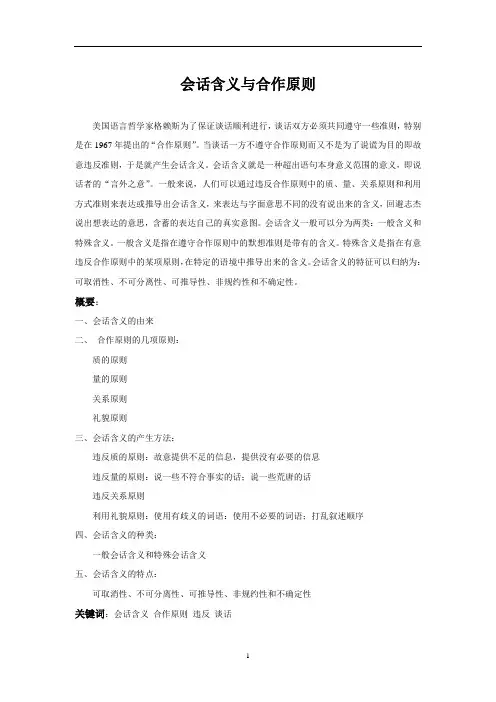
会话含义与合作原则美国语言哲学家格赖斯为了保证谈话顺利进行,谈话双方必须共同遵守一些准则,特别是在1967年提出的“合作原则”。
当谈话一方不遵守合作原则而又不是为了说谎为目的即故意违反准则,于是就产生会话含义。
会话含义就是一种超出语句本身意义范围的意义,即说话者的“言外之意”。
一般来说,人们可以通过违反合作原则中的质、量、关系原则和利用方式准则来表达或推导出会话含义,来表达与字面意思不同的没有说出来的含义,回避志杰说出想表达的意思,含蓄的表达自己的真实意图。
会话含义一般可以分为两类:一般含义和特殊含义。
一般含义是指在遵守合作原则中的默想准则是带有的含义。
特殊含义是指在有意违反合作原则中的某项原则,在特定的语境中推导出来的含义。
会话含义的特征可以归纳为:可取消性、不可分离性、可推导性、非规约性和不确定性。
概要:一、会话含义的由来二、合作原则的几项原则:质的原则量的原则关系原则礼貌原则三、会话含义的产生方法:违反质的原则:故意提供不足的信息,提供没有必要的信息违反量的原则:说一些不符合事实的话;说一些荒唐的话违反关系原则利用礼貌原则:使用有歧义的词语:使用不必要的词语;打乱叙述顺序四、会话含义的种类:一般会话含义和特殊会话含义五、会话含义的特点:可取消性、不可分离性、可推导性、非规约性和不确定性关键词:会话含义合作原则违反谈话C onversational Implicature and Cooperative PrincipleAmerican linguistics H.P.Grice once gave in 1967.In the speech, Grice said, the two sides of the conversation must obey some basic rules, especially the “cooperative principle”, to ensure that the conversation can go on propitiously. When one side of the principle doesn’t want to lie, conversational implicature comes out. Conversational implicature is a kind of meaning, which is beyond the sentence itself. Generally speaking, people can violate the maxim of quality, quantity, and relation and use the maxim of the manner to produce conversational implicature, which send the unsaid meaning of the words. Generally speaking, conversational implicature can be divided into two kinds: generalized implicature and particularized implicature. Generalized implcature refers to an implicature, which obeys the cooperative principle and also has the meaning. Particularized implicature refers to the implicature that violates some of the cooperative principle and makes the meaning in some specially context. The features of the conversational implicature: cancelability, no detachability, calculability, non-conventionality and indeterminacy:Key words:Conversational implicature cooperative principle violate conversationC onversational Implicature and Cooperative PrincipleAmerican linguistics H.P.Grice once gave speeches in 1967.In the speech. Grice said, the two sides of the conversation must obey some basic rules, especially the “cooperative principle”,to ensure that the conversation can go on propitiously. He believed the two sides of the conversation should have a same wish: the two sides can understand each other. So both of them obey some cooperative principles to achieve the aim. However, Grice said, not all the people in the conversation obey the rules. Once one side finds the other side not obey the cooperative principle, he will make himself try his best to understand the unsaid meaning in the conversation. So the conversational implicature comes out.As the conversational implicature has a close relationship with the co operational principle, we will introduce the cooperative principle first. In a conversation, the participants must first of all be willing to cooperate;Otherwise, it would not be possible for them to carry on the talk. This general principle is called the cooperative principle.There are four main maxims in the cooperative principle:●The maxim of quality: make your contribution as informative as required(for thecurrent purpose of the exchange);Do not make your contribution more informative than is required.●The maxim of quality: do not say what you believe to be false; do not say that forwhich you back adequate evidence.●The maxim of relation: the words have a relationship with other factors.The maxim of manner: avoid obscurity of expression; avoid ambiguity; be brief (avoid unnecessary prolixity); be orderly.The conversational implicature is a meaning out of the sentence itself; it is the speaker’s meaning under the literal. In the real life, people often violate some principles to sent some dark meaning.The meaning related with the cooperative principle may become by the following ways:First, to violate the maxim of quality1.Offer the deficient information on purpose.E.g.:One farmer meets Sam and says:“Hey, Sam, my horse’s got distemper. What did you give yours hen he had it?”“Turpentine,” grunted Sam.A week later they meet again and the first farmer shouts:“Sam, I gave my horse turpentine like you said and it killed him.”“S o did mine.” nodded Sam.第一位农妇的真正目的不仅是向Sam了解马病用了什么药,而且想了解治疗的结果,但通过对话它实际上只达到了一半的目标。
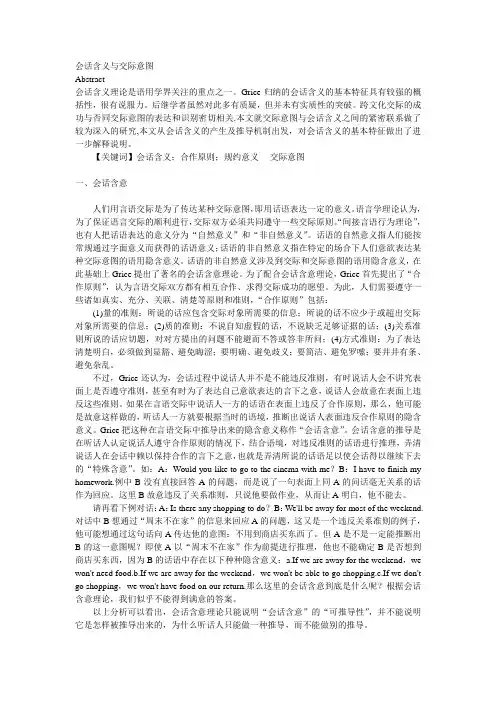
会话含义与交际意图Abstract会话含义理论是语用学界关注的重点之一。
Grice归纳的会话含义的基本特征具有较强的概括性,很有说服力。
后继学者虽然对此多有质疑,但并未有实质性的突破。
跨文化交际的成功与否同交际意图的表达和识别密切相关.本文就交际意图与会话含义之间的紧密联系做了较为深入的研究,本文从会话含义的产生及推导机制出发,对会话含义的基本特征做出了进一步解释说明。
【关键词】会话含义;合作原则;规约意义交际意图一、会话含意人们用言语交际是为了传达某种交际意图,即用话语表达一定的意义。
语言学理论认为,为了保证语言交际的顺利进行,交际双方必须共同遵守一些交际原则。
“间接言语行为理论”,也有人把话语表达的意义分为“自然意义”和“非自然意义”。
话语的自然意义指人们能按常规通过字面意义而获得的话语意义;话语的非自然意义指在特定的场合下人们意欲表达某种交际意图的语用隐含意义。
话语的非自然意义涉及到交际和交际意图的语用隐含意义,在此基础上Grice提出了著名的会话含意理论。
为了配合会话含意理论,Grice首先提出了“合作原则”,认为言语交际双方都有相互合作、求得交际成功的愿望。
为此,人们需要遵守一些诸如真实、充分、关联、清楚等原则和准则,“合作原则”包括:(1)量的准则:所说的话应包含交际对象所需要的信息;所说的话不应少于或超出交际对象所需要的信息;(2)质的准则:不说自知虚假的话,不说缺乏足够证据的话;(3)关系准则所说的话应切题,对对方提出的问题不能避而不答或答非所问;(4)方式准则:为了表达清楚明白,必须做到显豁、避免晦涩;要明确、避免歧义;要简洁、避免罗嗦;要井井有条、避免杂乱。
不过,Grice还认为,会话过程中说话人并不是不能违反准则,有时说话人会不讲究表面上是否遵守准则,甚至有时为了表达自己意欲表达的言下之意,说话人会故意在表面上违反这些准则。
如果在言语交际中说话人一方的话语在表面上违反了合作原则,那么,他可能是故意这样做的,听话人一方就要根据当时的语境,推断出说话人表面违反合作原则的隐含意义。

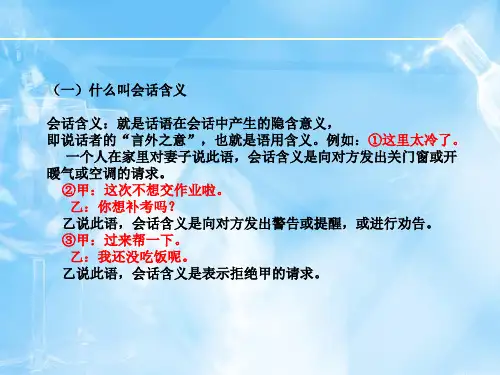
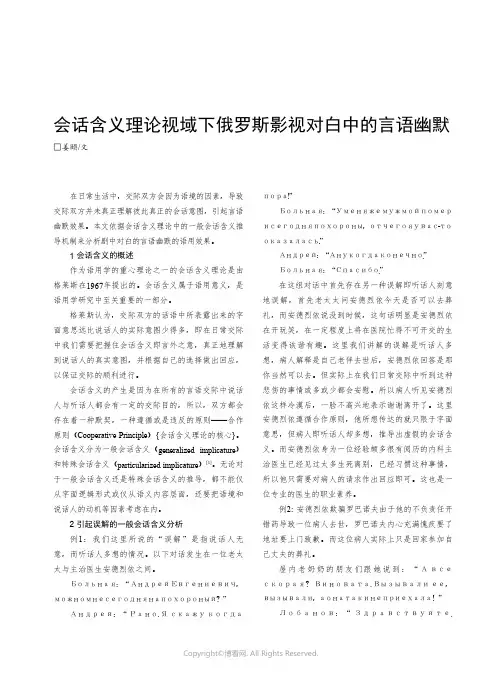
海外艺术 |26会话含义理论视域下俄罗斯影视对白中的言语幽默□姜颐/文在日常生活中,交际双方会因为语境的因素,导致交际双方并未真正理解彼此真正的会话意图,引起言语幽默效果。
本文依据会话含义理论中的一般会话含义推导机制来分析剧中对白的言语幽默的语用效果。
1 会话含义的概述作为语用学的重心理论之一的会话含义理论是由格莱斯在1967年提出的。
会话含义属于语用意义,是语用学研究中至关重要的一部分。
格莱斯认为,交际双方的话语中所表露出来的字面意思远比说话人的实际意图少得多,即在日常交际中我们需要把握住会话含义即言外之意,真正地理解到说话人的真实意图,并根据自己的选择做出回应,以保证交际的顺利进行。
会话含义的产生是因为在所有的言语交际中说话人与听话人都会有一定的交际目的,所以,双方都会存在着一种默契,一种遵循或是违反的原则——合作原则(Cooperative Principle ){会话含义理论的核心}。
会话含义分为一般会话含义(generalized implicature )和特殊会话含义(particularized implicature )[1]。
无论对于一般会话含义还是特殊会话含义的推导,都不能仅从字面逻辑形式或仅从语义内容层面,还要把语境和说话人的动机等因素考虑在内。
2 引起误解的一般会话含义分析例1:我们这里所说的“误解”是指说话人无意,而听话人多想的情况。
以下对话发生在一位老太太与主治医生安德烈依之间。
Больная:“ Андрей Евгениевич, можно мне сегодня напохороный?”Андрей:“ Рано. Я скажу когдапора!”Больная:“ У меня же муж мой помер и сегодня похороны, от чего я у вас-то оказалась.”Андрей:“ А ну когда конечно.”Больная:“ Спасибо.”在这组对话中首先存在另一种误解即听话人刻意地误解,首先老太太问安德烈依今天是否可以去葬礼,而安德烈依说没到时候,这句话明显是安德烈依在开玩笑,在一定程度上将在医院忙得不可开交的生活变得诙谐有趣。

格赖斯的会话含义学说
格赖斯的会话含义学说是一种心理学理论,强调人们在交流中的“含义性互动”。
该理论主张,人们不仅仅是传达信息,而是互相理解和创造意义。
根据格赖斯的理论,会话的含义来自于对话参与者之间的共同构建,而不是简单地从一个人传达给另一个人。
在这种共同构建的过程中,参与者的语言、语境、目的和背景都会影响会话。
这些要素决定了对话的含义和意义,并影响着人们如何理解和交流信息。
格赖斯的会话含义学说采用了对话框架的概念,框架是指一个由语言、语境、文化和背景等因素构成的认知框架,用来理解并解释相关事件、情境或信息的结构。
在对话中,参与者会根据他们的框架使用语言和信息来共同构建框架。
通过使用共同框架,参与者可以更容易地相互理解和传达意义。
然而,如果两个人的框架不同,那么他们可能会产生误解和沟通障碍。
这就是为什么在跨文化交流或者不同专业领域的交流中,针对他人的认知框架理解和选择合适的语言和信息非常重要。
在这种情况下,人们需要进行文化沟通和跨领域交流的训练,以便更好地理解和传达意义。
格赖斯的会话含义学说强调了人们在交流中的主动性和共同性。
这个理论认为,人们不断地共同构建意义,并以此来建立互相信任和理解的基础。
因此,这种理论具有很高的实用性和价值,可以帮助人们更好地理解和进行有效的交流。
会话含义的产生要有下列条件:会话含义的产生要有下列条件:说话者S的话语要有会话含义q,就必须:(1)假定S遵守合作原则;(2)为了使上述假定成立,就要推测出S认为q;(3)S了解,自己和听话者H都知道,H能推导出需要q来使“S遵守合作原则”这一假定成立。
而为了推导出会话含义q,听话者必须知晓:(1)S的话语的内容;(2)合作原则及其所属准则;(3)话语的上下文;(4)某些有关背景信息;(5)上述各条为S和H所共知Grice归纳出推导会话含义的下列步骤:归纳出推导会话含义的下列步骤:归纳出推导会话含义的下列步骤(1)他(S)说了话语P;(2)没有理由假定他不遵守合作原则;(3)他说了P,又确实在尽力合作(遵守合作原则),那么,他肯定认为q;(4)他肯定了解,我和他都懂得,要认为他遵守合作原则,就必须假定q;(5)他丝毫没有阻止我认为q;(6)那么,他就是要我认为q,故此,你的含义就是q。
4.5 Conversational ImplicatureUnlike conventional implicatures, conversational implicatures are produced by relating to the conversational context. To know what people mean, we have to interpret what they say. But interpretation is a tricky affair, and misunderstandings are always possible. As Leech remarks, ‘interpreting an utterance is u ltimately a matter of guesswork’. e.g. A: When is Tom’s birthday? B: It’s sometime in October. B’s implicature: the only thing he remembered about Tom’s birthday was the month in which it occurs, and that he honestly didn’t know whether it was at the begin ning, the middle or the end of that month.How does a conversational implicature come about? In analyzing an utterance, depending on strict semantic or logical criteria will not help. The ‘guesswork’ that Leech talks about will have to be of a somewhat qualified nature. The qualified guessing must depend on the context, that is, the circumstances of this particular question, the person involved in the situation, these persons’ background, etc. The more we know about this context, the more wellgrounded our ‘guesswork’ is going to be. e.g. A: I could eat the whole of that cake. B: Oh, thanks. A’s literal meaning: a statement of a fact. The context: an exchange between a guest and a host. A’s implicature: I compliment you on the cake, it is so delicious that I want to eat thewhole of it. e.g. A: Where is my box of chocolates? B: I was feeling hungry. I have got a train to catch. Where is your diet sheet? The children were in your room this morning. B’s semantic meanings: nonsense B’s intended meanings: He has eaten the chocolates as he was hungry. He took the chocolates as he got a train to catch. He hid the chocolates as he knew that A was on diet. (to lose weight, A should not eat them.) He suggested that the chocolates might be eaten by the children. Conclusion: The intended meanings of different speakers are not drawn from semantic or logical content of language, but are drawn from conversatinal implicature which tries to explain language use from functional, communicative and contextual aspects rather than from linguistic aspects which include phonology, syntax and semantics. Question: Why don’t people just say what they mean so as to avoid all ‘guesswork’ and ‘misunderstanding’? __ the way language users go about their communicative businesses Communication is not a matter of logic or truth, but of co-operative; not of what people say, but of what they can say under certain circumstances. According to Grice, the reason why people don’t say what they mean is that they try to be cooperative by observing certain rules in communication so as to make communication smooth and successful. 在言语交际中,一句话的全部意义,即有意图的信息交有意图的信息交流内容应作下列图式分解(Levinson,1983:131):流内容非自然意义(=有意图的信息交流内容)字面意义含义规约含义非规约含义非会话含义会话含义一般性会话含义特殊性会话含义由这个图式可以清楚地看到,Grice 认定“非自然意义”是由字面意义含义两部分共同组成字面意义和含义字面意义含义的。
因此,要全面地、深入地研究交际中话语的意义,就必须既研究话语的字面意义又研究话语的含义,而含义中又以会话含义最为重要。
语用学是在言语交际的总框架中研究话语意义的恰当表达和准确理解的。
正因为如此,“合作原则”和“会话含义”就成为重要的研究课题。
4.8 Flouting (违反)Grice’s Co-operative Principle Grice is aware that people do not always follow these maxims in language communication. He observes that sometimes people are overtly(公然地) and blatantly(露骨地)not following some maxims in order to exploit ‘implicature’ (as this is always the meaning that people intend to convey under certain circumstances) for communicative purposes. He calls this process as the flouting of co-operative principle.4.8.1 Flouting the Maxim of Quality a) Flouting the first sub-maxim of quality (do not say what you believe to be false) by saying things that are not true to the fact. The purpose is to force the addressee to make pragmatic implicature. Many figures of speech like irony, metaphor, hyperbole, rhetorical questions, etc. belong to this kind of flouting as shown in the following examples: A: What if the USSR blocks the Gulf and all the oil? B: Oh come now, Britain rules the seas! (irony) The fact: Britain has lost her controlling position over the seas since World War I. B’s implicature: since Britain no longer controls the seas, there is nothing that Britain can do. e.g. Queen Victoria was made of iron. (metaphor) The obvious false statement: no human beings are made of iron. The implicature: Queen Victoria has some of the incidental (伴随的)characteristics that are similar with iron like hardness, non-flexibility (坚固)or durability(耐久性). e.g. I was frightened to death. (hyperbole) The fact: the speaker is actually still alive and is standing on his/her feet. The implicature: I was extremely frightened at that time and you just cannot imagine how frightened I was. e.g. Was Mussolini going to be moderate? (rhetorical question) The fact: Mussolini was definitely not going to be moderate. b) Flouting the second sub-maxim of quality (do not say that for which you lack adequate evidence) by making irresponsible and insincere remarks as in the following example: e.g. A: Teheren’s in Turkey, isn’t it, teacher? B: And London ‘s in America, I suppose. B’s utterance is irresponsible and insincere. He deliberately violates the second sub-maxim of quality. By doing so, he wants to force A to reach an implicature: you are absolutely wrong and you are talking nonsense.4.8.2 Flouting the Maxim of Quantity a) Flouting the first sub-maxim of quantity (make your contribution as informative as is required for the purposes of exchange) by providing non-informative information as in, e.g. Dear Sir, Mr. Robinson’s command of English is excellent, and his attendance at tutorials has been regular. Yours, etc. Gener ally speaking, a recommendation letter should cover the referee’s comments on the applicant’s professional ability, creative ability and some of his personal characters. But this letter is non-informative to all these aspects. So the professor has obviously violated the first sub-maxim of quantity. The employer who got this letter would understand the implied meaning (implicature) in it. That is, the applicant was not suitable for such a job. b) Flouting the second sub-maxim of quantity (do not make your contribution more informative than is required) by either providing less or more information than needed as in the following humour, Aunt: How did Jimmy do his history examination? Mother: Oh, not at all well. They asked him things that happened before the poor boy was born. The mother violated the second sub-maxim of quantity by adding something more to her adequate remark. The mother’s implicature: failure in the examination is not the child’s fault. Tautologies (重复、赘述) (needless repetition) e.g. 1) War is war. 2) Either John will come or he won’t. 3) If he does it, he does it. Pragmatic implicature: 1) Terrible things alwayshappen in war, that is its nature and it is no good lamenting(悲哀) over that particular disaster. 2) Calm down, there is no point in worrying about whether he is going to come or not because there there is nothing we can do about it. 3) It is no concern of us.4.8.3 Flouting the Maxim of Relevance It is harder to provide examples of flouting the maxim of relevance because it is not easy to give responses that must appear irrelevant. Let’s see an example provided by Grice. At a genteel (上流社会的) teaparty, A says. A: Mrs. X is an old bag. There is a moment of appalled (可怕的)silence and then B says, B: The weather has been quite delightful this summer, hasn’t it? B’s remark implies that A’s remark should not be perhaps more specifically, that A has committed a social gaffe(出丑、失态). In appropriate circumstances, B’s utterance might imply: Hey, watch out, her nephew is standing right behind you! More example: Johnny: Hey, Sally, let’s play marbles. Mother: How is your homework getting along, Joh nny? This irrelevant remark must suggest something. Here Johnny’s mother is saying to him that he couldn’t play unless he has finished his homework.4.8.4 Flouting the Maxim of Manne r a) Flouting the first sub-maxim of manner (avoid obscurity) by giving obscure information as in the following exchange: Father: Let’s give the kids something. Mother: Okay, but I veto C-H-O-C-O-L-A-T-E. Mother’s implicature: she agrees with the father, but she doesn’t want their kids to eat chocolate. She is afraid that her kids might ask for some chocolate by hearing the word. She uses spelling and a Latin word ‘veto’ in order to make the utterance obscure for the small kids to understand. b) Flouting the second sub-maxim of manner (avoid ambiguity) by giving ambiguous(模糊的) information as in the followingconversation between a receptionist (服务员) and an associate(副) editor: A: Name and title. B: John Smith, Associate Editor and Professor. By using ambiguous structure, B intends to prevent A from knowing his true social status because ‘Associate Editor and Professor’ could mean both ‘’ associate editor and Associate Professor as well as ‘Associate Editor and Professor’. c) Flouting the third sub-maximof manner (be brief) by being wordy (唠叨的) as in a newspaper comment: e.g. Miss X produced a series of sounds that corresponded (符合)closely to the score (乐谱)of ‘Home, Sweet Home’. X 小姐发出了跟《家,甜蜜的家》的乐谱基本相当的一串声音。